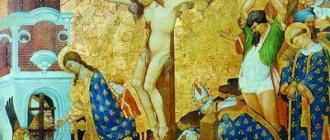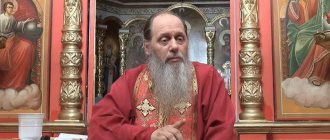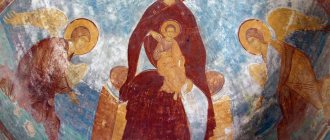“Apophatic” is a word that can be intimidating. Some other philosophical jungle on which it would be a pity to waste time and not understand anything? No no. Don't be afraid of unfamiliar words.
In fact, apophaticism is simply one of two approaches to understanding what God is. But it’s interesting to get closer to understanding the divine from a human point of view. Sometimes you just want to take a look behind the curtain of secrecy. So here it is, before us - we just need to understand how apophatic and cataphatic theology differ.
Knowing God is one of the main goals of religion
Knowing God is one of the central tasks of religion, although not the most important. The most important thing for a person on the spiritual path is to renew his connection with God. That is, to improve relationships.
And when were they spoiled? According to the Christian view, this happened during the Fall. And now all people are reaping the fruits of existence in the sinful, material world.
Religion is a renewed connection with God after the Fall.
“Re” is a prefix that indicates renewal, and together with the root it means “to bind again, to reunite.” That is, this is a path that every person can go through again in order to enter their original, spiritual state. To do this, there is no need to understand what God is.
Indeed, we can simply lead a decent life, have superficial ideas about our tradition and never go deeper. From the point of view of Christian dogma, this will be enough, and apophatism will not be useful here.
However, not every one of us wants to move blindly, right? If you strive for something, then it would be better not to move into the black abyss of the unknown, but straight to some object about which we can say something. Actually, this is where the need to know God arises.
Immanence and Transcendence of God
Supporters of apophatic theology, as a rule, proceed from the transcendence of God, that is, the transcendence of God to the created world, emphasizing His existence on the other side of the existence He created and all types of human experience, inaccessibility to knowledge.
As the Cause of all that exists, God is beyond all that exists, infinitely rises above all created being, and is the One who exists above all that exists. St. Gregory of Nyssa wrote: The nature of God, in itself, in its essence, is above all comprehending thinking, it is inaccessible and elusive to any rational methods of thought, and no power has yet been discovered in people capable of comprehending the incomprehensible
.
At the same time, according to the teachings of the Church, only the Divine nature (essence) is transcendental, but not the Divine actions (energies), in which God becomes immanent in created being. “What is invisible by nature becomes visible through action”
, notes St. Gregory of Nyssa.
Revealing Himself in His energies, God remains essentially unapproachable. Thus, God is both transcendent and immanent in creation. “God remains transcendent by nature in the very immanence of His manifestation.”
, - points out the Orthodox theologian V. N. Lossky
God can be known well by interacting with Him
But we have all heard about the unknowability of God. There are hardly any religious traditions that seriously consider this possibility. There is another possibility - a personal meeting with God, getting to know Him.
A person has a lot of acquaintances, doesn’t he? We can know Uncle Vasya well from the next apartment, have a rough idea of how he communicates, but we will still remain infinitely removed from a full understanding of his deep nature.
There can be no question of a complete understanding of the inner world of man. Someone else's head is darkness and wilds.
The love of God in Christianity is unconditional; it does not require a person to know everything about Him.
Every person in this world will always remain infinitely lonely, no matter how much he strives for communication. There are things that you cannot say even to your closest person; many of our interests will not be shared by the majority of those around us. Something will forever remain highly personal for each individual.
This is understandable, because we do not live in an anthill, where we can assume a collective intelligence. But sometimes we want to have someone who would understand us 100% and accept us with love and without judgment.
And such a creature really exists. This is the Supreme Lord. He is our Father, although not in a physical sense.
In relation to God, one cannot directly use the categories of the material world, only metaphors. The main thing here is that God is the one with whom we can establish a relationship, because He knows us perfectly. But at the same time we are too limited to know it.
Apophatic philosophy is a method of knowing God intellectually.
Dionysius the Areopagite
The origins of apophatic theology originate from the works of this man. In church tradition he is mentioned as a disciple of the Apostle Paul and the first Greek bishop. Dionysius wrote a number of texts that became most widespread four hundred years after his death. In the fifth century the claims were questioned and generated much controversy. However, it was these works that influenced today's concepts of apophatic and cataphatic theology.
Dionysius lived in Athens, where he received a classical education for Greece at that time. According to ancient writings, he witnessed the solar eclipse during the execution of Jesus Christ, and he also attended the funeral of the Virgin Mary. Because he continued the work of the Apostle Paul, he was thrown into prison. Dionysius accepted a martyr's death. During his death, a miracle was performed: the headless body of the saint stood up, took his head in his hands and walked. After six kilometers the procession ended, the holy head was handed over to the hands of a pious woman. The body was buried where it fell. Today the Church of Saint-Denis stands on this site.
Cataphatics - knowledge of God through logical statements
Let's start with a brief analysis of what cataphatics is.
The essence of this approach is the idea that God, to one degree or another, reflected His own qualities in the world He created. For example, when we encounter something beautiful, this is certainly an echo of the Divine in our world.
The beautiful is like a projection of God into the material world. Therefore, you can collect all these “evidence” and use them to recreate the image of God, to understand what He really is like.
For example, Christianity claims that God is love. This is a very convenient design, because a person understands perfectly what love is. It may not be material, but it is a feeling, and everyone is capable of experiencing it.
Cataphatics is the projection of the human onto the Divine. For example, this includes the idea that God is love
In addition, this feeling, to one degree or another, is reflected in material reality. When the object of a person’s adoration is nearby, the heart begins to react, beat faster, sweat appears, and the person shows signs of excitement. Although we do not feel with our hearts, there is still something true in the romanticized idea of this organ.
This is one end of the thread that is given to the earthly world. And at the other end there is God, the Supreme Being, and perhaps a feeling, or something that has no name. But when we experience love, it turns out to be something very close to God.
3 quality
God is given by the Gaudiya-Vaishava tradition: eternity, knowledge, happiness
Other traditions teach much the same thing. For example, Gaudiya Vaishnavas highlight the following qualities of the Absolute God:
- Eternity - He was never born and will never die.
- Knowledge - God knows everything.
- Happiness/Bliss – God always exudes and experiences happiness.
By the way, John Chrysostom wrote about the same thing when he argued that God is love and nothing earthly can upset or anger him. For a person, it is too bold and stupid a thought to believe that in his earthly life he is capable of doing something that can anger the Almighty.
But let's return to the Gaudiya Vaishnavas. They claim that every person (and moreover, every living being) contains within himself a desire for Divine properties:
- Denial of death . We are all mortal and we all know that we will die. But no one wants to die. Any living creature fights for life to the last, as if the idea of ceasing to exist seems a mistake to him. Where would this come from if nowhere in earthly life does he encounter confirmation of eternal existence? It is clear that it is from the spiritual world.
- A thirst for knowledge . This is not about a passion for textbooks, but about the fact that each of us would prefer to know something than not know something. But at the same time, we understand that we will never contain all the knowledge in the world. Why then strive for this? Because we have this nature to strive for God.
- Pursuit of happiness . No one will voluntarily go to hardships. Even an ascetic decides to undertake a feat for the sake of the spiritual benefits that it will bring him. A person who sacrifices himself for another does so because the knowledge of saving the life of another will bring him satisfaction, and cowardice would lead to suffering. Even a person who has been blackmailed into doing something obeys because it is the least traumatic option for his life. A person always prefers the best options in everything.
And to sum it up, it remains that no one is eternal, omniscient, or happy. The material world differs from the spiritual world in this way.
But it is not only through these categories that the divine can be “attacked.” The cataphatic method is quite broad. The famous Christian thinker Thomas Aquinas argued that beauty is the reflection of the divine nature in the world. Beauty is subject to special laws that can be assessed objectively, and it can manifest itself at a variety of levels:
- Material;
- Mentally;
- Dukhovny.
The perfect work of art is, of course, an act of human creation. But, firstly, it reflects the nature of the Creator, and secondly, it reveals to the world the divine beauty of harmony. Therefore, mastery is a kind of degree of knowledge of God.
Holy Fire
In the middle of the sixteenth century, the priests of the Armenian church managed to bribe Sultan Murat. For this, the mayor promised not to allow Orthodox Christians into the Church of the Holy Sepulchre. Patriarch Sophrony IV, who came to celebrate Easter with his parishioners, saw a lock on the door. This event upset the Orthodox so much that they remained standing at the door, crying and grieving over their excommunication from the shrine.
The Armenian Patriarch prayed day and night to no avail for the descent of the Holy Fire in the Edicule. The Lord waited exactly 24 hours for repentance from the Armenians, but it did not happen. Then a ray of light struck from the sky, as usually happens during the descent, but it did not hit the Edicule, but the column where the Orthodox stood. Flashes of fire sprayed from the column. The worshipers rejoiced and lit their candles.
The loud rejoicing attracted the attention of the Turkish soldiers standing in the enfilades. One of them named Anwar, seeing the miracle, instantly believed and shouted: “The true faith is Orthodox, I am a Christian!” Colleagues, drawing axes, rushed towards Anwar in an effort to kill the former Muslim, but he managed to jump down from a ten-meter height.
Then the Lord showed another miracle. Anwar did not die when he fell on the stones of the square. The slabs at the place where he fell became waxy, which significantly softened the young man’s fall. At the place where the desperate soldier jumped, his traces remained.
The Muslim brothers executed Anwar and tried to destroy the traces of his fall, but the slabs froze. Pilgrims can see the column and its footprints with their own eyes even today. Since then, only the Orthodox patriarch has prayed for the descent of the fire. If the proponents of the ecumenical idea of the unity of God are right, then the miracles of the sixteenth century lose their meaning.
Dogmatic theology rejects these errors. We can say that this science exists to refute such near-Christian deviations. The dogmas are divided into two parts: God Himself and His relationship to creation: the world and man. Apophatic theology in Orthodoxy does not refute dogmas. This is a method based on the practice of Orthodox ascetics.
Apophathia - the path of denial
Apophathia is the path of denial. This method is no less interesting and logical than the previous one. The point here is that God is a deliberately immaterial and unconditioned being.
When we talk about the spiritual world, we translate all this into the language of metaphors, that is, we replace unknown elements with images familiar to us. Comparisons are always an imprecise means that has its own errors. A model is not the object itself, a map is not the territory, and therefore we cannot be treated equally.
From the point of view of human experience it is impossible, for example, to describe what the Holy Trinity is. Therefore, apophaticism does not try to rely on it
It is easy to compare God to a parent. But this approach forces us to project the human onto the Divine, that is, to simplify and, as a result, to be mistaken.
To understand how untenable the approach of metaphorizing the transcendental Deity is, it is enough to ask the question, what is the relationship between the members of the Holy Trinity when compared with their earthly equivalents?
- Parental? Not at all. God the Father is far from performing parental functions in relation to Jesus Christ. They are equal in their powers, according to Christian dogma, minus a couple of nuances that have nothing to do with the family. And the Holy Spirit is clearly not the son or father of anyone in this triad.
- Fraternal? And here by. They have no common parent, no competition and no brotherly love. There is no place for family analogies at all. And yet there is clearly a relationship.
You can continue to refine your comparisons, but the result will be the same: the transcendental remains as such and does not fit into material concepts.
Based on this, adherents of apophatia propose their own approach: discard everything that is not God, erase it from your idea of Him. The bottom line is that we will discover that there is God.
This is quite difficult to realize in the example of the Most High Himself, but it is easy to see in the example of one Buddhist practice of denial. The person begins to reason: “This is my leg, but it is not me,” and crosses out the leg. Then he says: “The head is not me either.” He searches for himself with these reasonings until he reaches amazing results: thoughts are also not “I”.
By denying the elements of this world, one can come to the concept of God.
The result of such meditation is often shocking: the practitioner understands that “I” is also an idea, and it comes from somewhere else, where there is something else. Or maybe there is nothing. And at that moment a logical stupor occurs, as a result of which a person finds himself and enlightenment occurs.
It is useful to transfer the same scheme to Christian soil: God is not a person, not the world he created, not feelings, not energies, not life, not death, not the Moon, not the Sun, etc. Anyone can practice such intellectual searches.
But at the same time, Orthodox theologians, recognizing the benefits of such research, do not consider either apophatic or cataphatic to be exhaustive methods of knowing God. Most likely, there is truth in both approaches, but this problem needs to be solved using complex methods. Including spiritual life.
By leaving a comment, you accept the user agreement
About divine names
This treatise reconciles two methods of knowing the truth. First, the author lists the names of God described in the works of Hierotheus of Athens, Ephraim the Syrian and other theologians. It is precisely this method that underlies cataphatic theology. However, the author (unlike the Neoplatonists) does not doubt the absolute transcendence of the Creator. The main message of the treatise is that God reveals himself only through grace, only to those to whom He Himself decides. Neoplatonism preaches knowledge through catharsis, that is, cleansing from sins and the desire for holiness.
Dionysius in his works refutes Neoplatonic truths, speaking about the impossibility of knowing God in this way. In other words, cleansing from sins is needed not by God, but by man, and therefore cannot serve as the only true path.
Later, a conclusion was drawn that reconciled the two philosophers. It says that God reveals himself through grace, but with the counter efforts of man. The seeker of truth must be an ascetic. You need to cut off everything unnecessary from your life, from yourself. This will help to accommodate the fullness of understanding of the existence of God. A person must turn into an empty vessel. When we are surrounded by the world with its temptations, values and opportunities, is there time to search for truth?
When everything unnecessary is cut off, the work of thought begins. For this, people go to monasteries, where the entire structure is aimed at saving the soul and thinking about the eternal. The saints of previous centuries went into the desert for purification and repentance. In solitude and prayer they acquired the Holy Spirit and, under His influence, wrote their works. This theme is fully revealed in the apophatic purification of philosophical concepts in theology.
Miracle in Lanciano
In the eighth century, a Liturgy was celebrated in an Italian city. The priest preparing the Holy Gifts suddenly doubted the sacrament. Reflecting, he came to the conclusion that the Eucharist is just a tribute to the memory of the Last Supper. Suddenly the bread in the hands of the priest turned into a thin slice of flesh, and real blood splashed in the bowl. The man of little faith was surrounded by monks, to whom he told about his doubts.
The shrine has been in this temple for twelve centuries. The cut does not change, and the blood has collected in five identical lumps. It's amazing that each blood ball weighs the same as all five taken together. Obvious violations of the laws of physics have interested scientists. Research has shown that the blood and flesh belong to the same group as on the Shroud of Turin.
Orthodox miracles
“If I see it, I will believe it,” said the man. “If you believe it, you will see,” God answered.
Inexplicable phenomena occurred in everyone's life. Many miracles are described in the lives of saints, some of which are referred to in theology. What is a miracle? What is the meaning behind these phenomena? The answer to these questions interests not only scientists, but also ordinary people. Christianity is the religion in which the most miracles happen. Orthodoxy is a confession where there are a huge number of saints and martyrs.
Miracles are divided into several types. There are major events, such as the appearance of icons, the flow of myrrh, the Holy Fire or the cloud on Mount Tabor. The second type is private miracles performed by God through the prayers of believers through Orthodox saints. The first ones are well studied by science, but are still questioned to this day. Miracles in the destinies of people are aimed at enlightening a specific person as an impetus for correction.
Cloud on Mount Tabor
Every year on the day of the Transfiguration of the Lord a cloud appears over the Orthodox monastery. Believers are enveloped in a shroud of fog, leaving moisture on the skin. Those who have experienced the miracle for themselves unanimously repeat that the cloud is alive. In 2010, meteorologists began studying this phenomenon. After making the necessary preparations, we took air samples. It must be said that in the climate of those places there are no clouds, as it is too hot. The air is hot and dry. Analyzes carried out by meteorologists confirmed this fact.
As soon as the Liturgy began, the air thickened and clouds appeared. The monastery was shrouded in fog. It covered both the buildings and the congregation. The clouds resembled clots of steam, touched people and moved in the complete absence of wind. The miracle was captured on video camera. When viewing the material, chaotic movements of steam were noticeable against the background of motionless cypress trees. Air samples left no doubt. Scientists said that with such parameters the formation of fog is impossible. Orthodox theologians associate this event with the Transfiguration of Jesus Christ. It was on Mount Tabor that He appeared to His disciples after the Resurrection.





